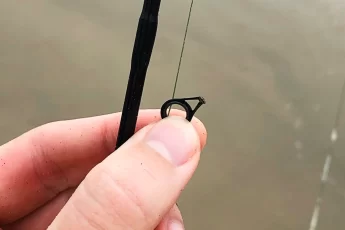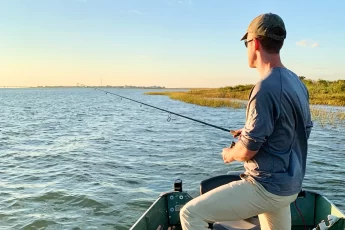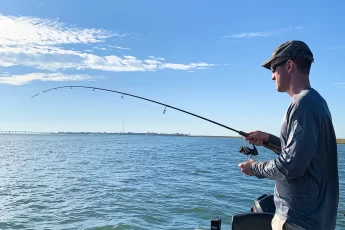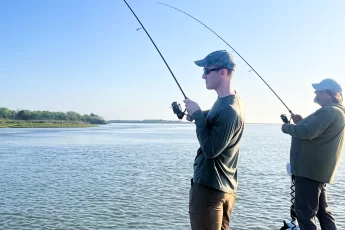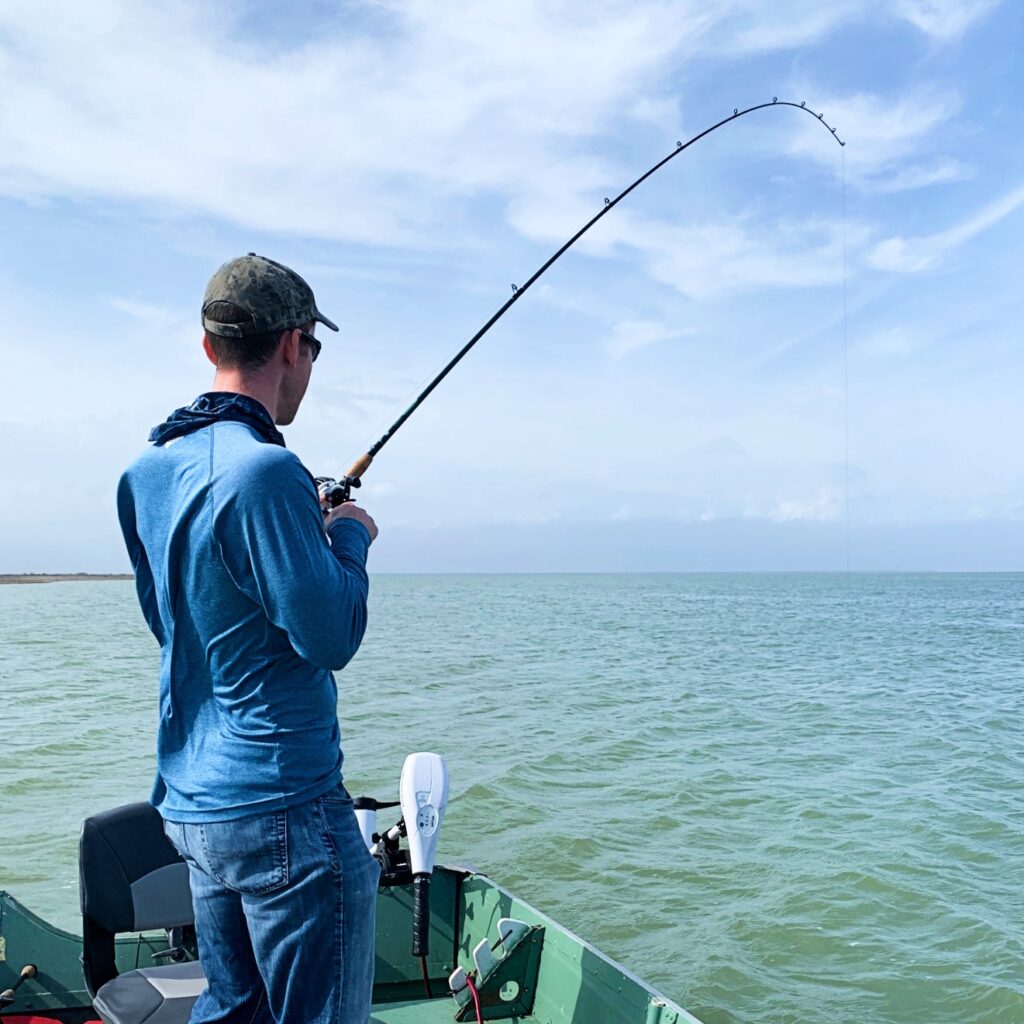
Updated 2/13/2024
Looking for the best saltwater fishing rods on the market? Look no further. I’ve done the hours of rod research and testing on weight, strength, durability, and material quality so you don’t have to.
Saltwater fishing covers a huge range of applications from deep sea jigging for tuna, to surf fishing, to chasing tailing redfish in the marsh. All the while, saltwater is doing its best to corrode your gear. Having the right saltwater fishing rods in your arsenal is crucial for catching fish.
Check out our top recommendations by category of saltwater fishing to have the right rods for the job.
*Disclosure: I only recommend products I would use myself and all opinions expressed here are my own. This post may contain affiliate links that at no additional cost to you, I may earn a small commission.
Our Top Picks
Many rods on our list comes in spinning and casting versions. Both are great options. We recommend spinning rods as all-around options and as more beginner friendly. Casting rods are easier to cast accurately but can be tricky if you aren’t as experienced with casting reels.
- Best Overall: Penn Battalion II Inshore Rod
- Best Under $100: Ugly Stik Bigwater Rod
- Best Under $200: St. Croix Triumph Inshore
- Best for Surf Fishing St. Croix Triumph Surf Rod
- Best Rod & Reel Combo: Penn Battle III Rod & Reel Combo
- Best for Offshore Fishing: Penn Carnage III Boat Rod
- Best High End St. Croix Legend Tournament Inshore Rod
The Best Saltwater Fishing Rods
Whether you’re a new angler or a grizzled expert, we have you covered. Check out our recommendations for best overall saltwater rod as well as budget, surf, offshore, and splurge options!
1. Penn Battalion II Inshore Rod
- Length: 7′ to 8′
- Rod Material: SLC2 Carbon
- Guides: Fuji Alconite
- Handle: Premium Cork or Rubber Shrink Tube
- Warranty: 1 Year manufacturing defects only
Pros:
- Highly versatile for multiple saltwater fishing applications
- Premium rod features for reasonable price
Our top choice for best saltwater fishing rod is the Penn Battalion II Inshore Rod. This rod captures a great balance of value, price accessibility, and quality features. It’s an all around workhorse saltwater fishing rod that is perfect for anything the ocean can throw at it.
Picking a top overall choice proved challenging. Is this rod perfect? No. Is it solid equipment for the price? Definitely.
We picked an inshore rod as our top saltwater fishing rod because of its versatility. You can successfully catch fish with this rod in every saltwater application. You can use it for snapper on offshore structure, redfish and trout in back marshes, surf fishing for bull reds, and anything in-between. This type of rod is not the best choice for all saltwater fishing applications, but it CAN work for most everything.
For surf fishing that requires long casting distances or offshore fishing for huge species, think about getting a specialized rod for those applications. Otherwise, the Battalion II has you covered.
The SLC2 Carbon rod blank and Fuji Alconite guide material construction are considered mid-tier materials that should last plenty long with proper care. The full cork handle feels great for prolonged saltwater fishing trips. We do wish Penn offered a better warranty (like St. Croix), but it’s hard to complain at this price point.
For other great inshore rod choices, check out our article on the best inshore fishing rods.
2. Ugly Stik Bigwater Spinning Rod
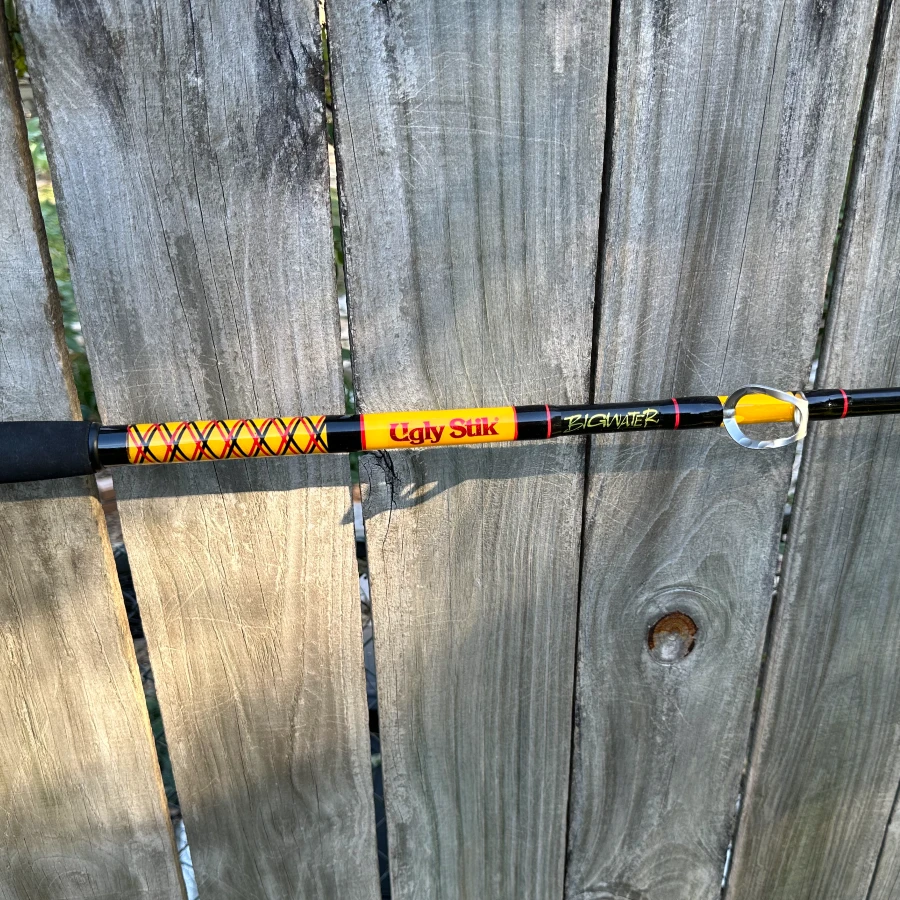
- Length: 6’6″ to 15′
- Rod Material: Ugly Tech (combo graphite & fiberglass)
- Guides: Stainless Steel
- Handle: EVA Foam
- Warranty: 7 Year manufacturing only
Pros:
- Budget friendly
- Wide size range makes it a great budget option as a shorter inshore rod or longer surf rod
Our choice for the best saltwater fishing rod under $100 is the Ugly Stik Bigwater Fishing Rod. In this case, budget pricing doesn’t mean budget performance.
This rod is plenty sturdy. It’s heavier and less sensitive than most other similar class rods. The stainless steel inserts will succumb to saltwater corrosion quicker than pricier alternatives. The foam handle is functional and feels fine (although we personally prefer cork!).
We love that this rod comes in a huge range of sizes and it has a better warranty than many of the pricier rods available. This is a great saltwater option for both inshore or surf fishing. For inshore, get one around 7′. For surf fishing we recommend 10-12′.
This is an excellent budget option that can catch fish just as well as higher-end rods. Don’t think twice about adding an Ugly Stik Bigwater to your fishing arsenal.
For additional reading, check out our article on the best saltwater fishing rods under $100.
3. St. Croix Triumph Inshore
- Length: 6’8″ – 7’6″
- Power: Medium-Light to Heavy
- Rod Material: SCII Carbon
- Guides: Aluminum-oxide
- Handle: Full Cork
- Warranty: 5 year
Pros:
- Great value for the money
Our choice for the best saltwater rod under $200 is the Triumph Inshore Fishing Rod. This price point is the best bang for your buck for balancing quality and price. This rod line is a workhorse saltwater fishing rod that can handle almost everything you throw at it.
The 7 foot, medium power, fast action Triumph Inshore in either spinning and casting is a great option as the best redfish and speckled trout rod on this list.
A 7 foot, medium power spinning Triumph Inshore has been my recent go-to rod for bottom fishing live shrimp on a fish-finder rig in tidal channels near the San Luis pass on the Texas coast. I found a stretch of shell bottom near moving current and this setup has been deadly for slot reds, big flounder, speckled trout, black drum, and sheepshead. The Triumph Inshore has the sensitivity for me to feel my sinker and shrimp drift with the current over the shell bottom and the backbone to handle hits from bigger inshore fish.
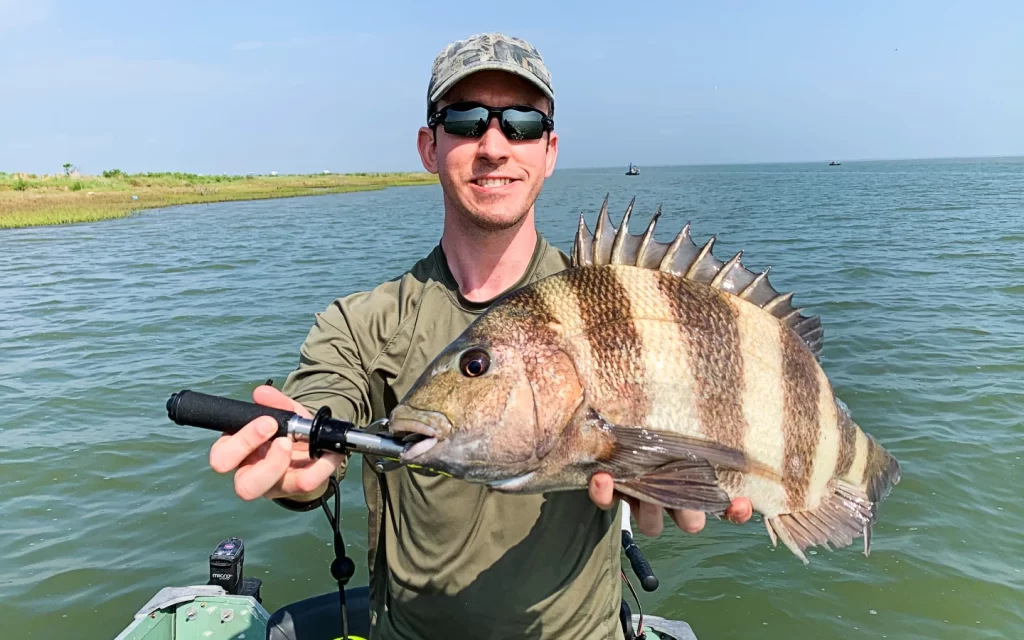
This rod is made with saltwater rated components on a strong, lightweight, and sensitive rod blank. It’s perfect for chucking popping corks, working soft plastics, or soaking shrimp trying to catch reds and specks.
The full cork handle feels great. There’s plenty of backbone in the medium power (or heavier) versions to deal with slot redfish while still maintaining excellent sensitivity to detect subtle strikes.
I previously had the St. Croix Mojo Inshore rod as our best inshore rod under $200 but decided to transition to the Triumph. The Mojo inshore was revamped in 2021. My Mojo Inshore rods from before 2021 have held up incredibly well. I had one Mojo Inshore built after 2021 that broke near the tip after just a few uses which I’ve seen is a common problem on assorted forums. Even though St. Croix’s warranty is incredible, I couldn’t in good-conscience keep the Mojo Inshore in a top slot.
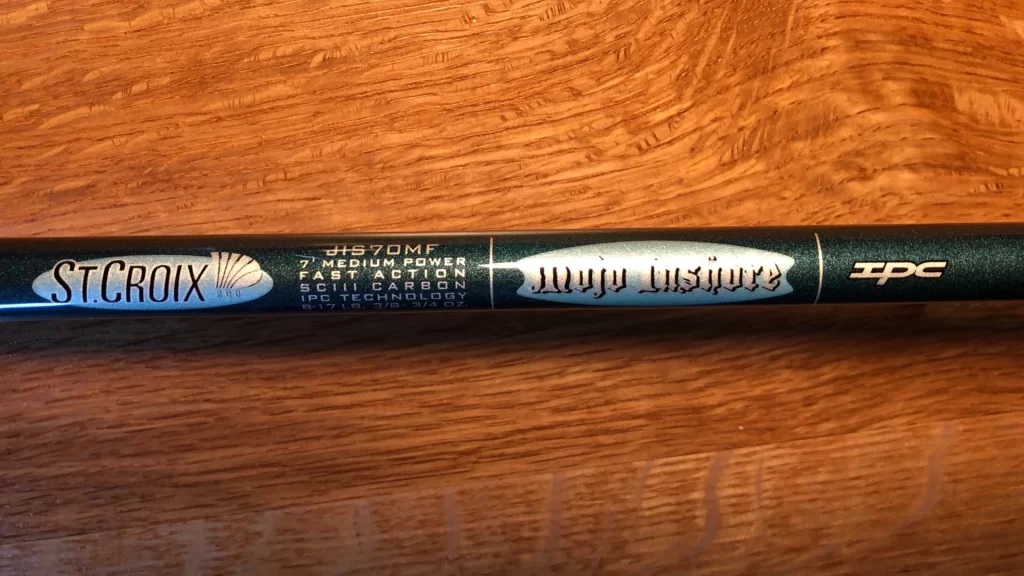
4. St. Croix Triumph Surf Rod
- Length: 7′ to 10’6″
- Rod Material: Graphite
- Guides: Aluminum oxide
- Handle: Cork Tape
- Warranty: 5 Year
- Available in 2 and 4 piece versions
- Heavy duty travel case with the 4 piece travel version
Pros:
- 36″ hard-sided travel case for the 4 piece version is a delight to transport
- Long, comfortable cork tape handle
- Premium rod features for reasonable price
Our top choice for best surf rod is the St. Croix Triumph Surf Rod because it nails that perfect mix of features and value we’re always looking for. Make sure to check out our in-depth review of the Triumph Surf!
Surf fishing usually requires long casting distances. This means that surf fishing rods are much longer than regular fishing rods. We recommend surf rods around 10 feet long because you can cast what feels like a mile but the rod isn’t too big to become unmanageable. For a deeper dive on surf fishing rods, check out our article on the best surf fishing rods.
St. Croix rods are synonymous with quality and the Triumph Surf Spinning Rod is no exception. We love the feel of the long, split cork table handle. It is comfortable and the rod casts like a dream.
The rod blank is St. Croix’s proprietary SC II graphite fiber which is lightweight, durable, and sensitive with a higher strain rate than fibers commonly used by other rod manufacturers. The Triumph Surf Rod is on the lighter end of available surf rods with superior sensitivity without sacrificing strength.
5. Penn Battle III Spinning Rod & Reel Combo
- Rod Length: 6’6″ to 10′
- Rod Power: Light to Heavy
- Rod Material: SLC2 Carbon
- Reel Size: 1000 to 8000
- Reel Ball Bearings: 5+1
Pros:
- Wide range of available rod and reel sizes and powers for various applications
- Great value for the price
- One stop shop for beginners
Our choice for the best saltwater rod & reel combo is the Penn Battle III Spinning Rod and Reel Combo. This combo is that perfect mix of premium quality with a manageable price tag. It is an excellent entry point for a one-stop-shop saltwater fishing rod and reel setup for beginners. It also comes in a wide variety of rod lengths, reel sizes, and powers so a prudent angler can pick the right setup for their needs.
Heck, the Penn Battle III reel is our choice for best saltwater spinning reel so it’s no surprise if you slap it on a decent rod we’ll think highly of it!
The reel was the 2020 ICAST Online Best of Category Winner – Saltwater Reel, includes a 5+1 sealed stainless steel ball bearing system, Penn’s HT-100 carbon fiber drag washers, and a full metal aluminum body and side plate. It is high quality designed for durability and performance and Penn really outdid themselves with the attention to detail.
The rod blank is a graphite composite with either cork or eva handle depending on the model. It has plenty of backbone to reel in big inshore species like redfish, striped bass, and speckled trout. We do feel like the rod blank lacks the sensitivity compared to the full graphite blank rods on this list but we don’t think this is a big problem inshore fishing. Most inshore fish, with the notable exception of flounder, hit like a ton of bricks and sensitivity isn’t a major deciding factor for picking a rod.
While we generally expect a rod & reel combo to skimp in quality on one of the components, we were pleasantly surprised with this pairing by Penn. This combo is great value for the price.
Check out our article on best surf fishing saltwater rod and reel combos and our article on the best saltwater rod and reel combos for further reading on why we like this combo so much. For saltwater rod and reel combos we recommend getting a rod closer to 7 feet long with roughly a 4000 series spinning reel.
6. Penn Carnage III Boat Spinning Rod
- Length: 6’6″ to 8′
- Rod Material: SLS3 Composite (Carbon fiber & fiberglass)
- Guides: Fuji K-Series with SiC (silicon carbide) Inserts
- Handle: Full Rubberized Shrink Wrapped
- Warranty: 1 Year manufacturing defects only
Pros:
- Serious backbone for serious offshore fish
- Sea-Guide Aluminum Reel Seat & Aluminum Gimbal
Our choice for best offshore saltwater fishing rod is the Penn Carnage III Boat Spinning Rod. This rod is the perfect choice for reeling in sea monsters from the depths because of it’s high build quality and strength.
Offshore fishing from a boat challenges fishing rods in a unique way. Casting distance is less of an issue and durability, reliability, and rod strength come to the forefront. Reeling in big fish like mackerel, tuna, mahi-mahi, tripletail, sailfish, grouper, and sharks puts huge demand on your gear.
Offshore fishing techniques like heavy jigging can put extra strain on the reel seat. We love that Penn put the reinforced Sea-Guide Aluminum reel seat on this rod for that extra bit of strength. Also, the aluminum gimbal on the butt of the rod is a nice touch when the rod is under heavy strain in a fighting belt.
7. St. Croix Legend Tournament Inshore Spinning Rod
- Length: 7′ to 7’11”
- Rod Material: SCIV+ Carbon Fiber
- Guides: Alconite & Stainless Steel
- Handle: Super Grade Cork
- Warranty: 15 Year
- Integrated Poly Curve (IPC), Advanced Reinforcing Technology (ART), Fortified Resin System (FRS)
Pros:
- The best money can buy
- Made in the USA
Our choice for the best high end saltwater fishing rod is the St. Croix Legend Tournament Inshore. This is rod is just about the strongest, lightest, and most sensitive saltwater fishing rod on the market. We love the full cork handle, top end construction materials that should last forever, and St. Croix’s 15 year warranty. Our experience with St. Croix’s customer service has always been stellar so we feel it’s important to mention.
To top it all off, they make this rod line is made locally in Park Falls, Wisconsin!
The rod features four of St. Croix’s innovative technologies.
SCIV+ is St. Croix’s next gen, super high modulus carbon fiber. It is a hybrid carbon fiber blank enhanced with new IACT Glass technology that makes for a lighter, stronger, and more sensitive fishing rod.
Integrated Poly Curve (IPC) eliminates all transitional points in the rod blanks for smoother actions, increased strength, and greater sensitivity.
Advanced Reinforcing Technology (ART) is an exotic carbon fiber material that adds a magnitude (10x) of strength with virtually no increase in rod blank diameter or weight and significantly improves the hoop strength of the blank by preventing it from deforming under severe loads.
And last but not least, rods manufactured with the Fortified Resin System (FRS) advanced manufacturing protocol consistently test 33% stronger than those built with standard resins and curing methods.
Rod Comparison Table
Check out our handy comparison table showing key specifications for our top rod choices.
| Rod Name | Length | Rod Material | Guides | Handle | Warranty |
|---|---|---|---|---|---|
| Penn Battalion II Inshore Rod | 7′ to 8′ | SLC2 Carbon | Fuji Alconite | Premium Cork or Rubber Shrink Tube | 1 Year manufacturing defects only |
| Ugly Stik Bigwater Spinning Rod | 6’6″ to 15′ | Ugly Tech (combo graphite & fiberglass) | Stainless Steel | EVA Foam | 7 Year manufacturing only |
| St. Croix Triumph Surf Rod | 7′ to 10’6″ | Graphite | Aluminum oxide | Cork Tape | 5 Year |
| Penn Carnage III Boat Spinning Rod | 6’6″ to 8′ | SLC3 Composite (Carbon fiber & fiberglass) | Fuji K-Series with SiC (silicon carbide) Inserts | Full Rubberized Shrink Wrapped | 1 Year manufacturing defects only |
| St. Croix Legend Tournament Inshore Spinning Rod | 7′ to 7’11” | SCIV+ Carbon Fiber | Alconite & Stainless Steel | Super Grade Cork | 15 Year |
| Penn Battle III Spinning Rod and Reel Combo | 6’6″ to 10′ | SLC2 Carbon | Penn Dura-Guides | Cork or EVA | – |
| St. Croix Triumph Inshore | 6’8″ – 7’6″ | SCII Carbon | Aluminum-oxide | Full Cork | 5 year |
Conclusion
The best saltwater fishing rods need to cover a wide range of fishing techniques and target species. Our overall choice for best saltwater fishing rod is the Penn Battalion II Inshore rod because of it’s versatility and value for the money.
What are you waiting for. Get out there and catch some fish!
Check out our articles for great reels to pair with these rods:
- Best Saltwater Reels
- Best Saltwater Baitcasting Reels
- Best Saltwater Spinning Reels
- Best Inshore Reels
- Best Reels for Redfish and Speckled Trout
- Best Surf Fishing Reels
- Best Conventional Reels
- Best Trolling Reels
Check out our related rod articles:
- Best Saltwater Rod & Reel Combos
- Best Inshore Fishing Rods
- Best Rods for Redfish and Speckled Trout
- Best Beginner Fishing Rods
- Best Mahi Mahi Rods
- Best Flounder Rods
- Best Sheepshead Rods
- Best Surf Fishing Rods
- Best Surf Fishing Rod & Reel Combos
- Best Pier Fishing Rods
- Best Trolling Rods
How to Choose The Best Saltwater Fishing Rod For You
Choosing the best saltwater fishing rod should account for factors like rod power, action, materials, and portability.
For even more reading, check out our article on how to choose any fishing rod.
Saltwater Rod Length
Saltwater anglers should pick rod length based on what type of fish they are after and what kind of fishing they intend to do. Generally, longer rods can cast further, and shorter rods are easier to maneuver and are sturdier.
Surf fishing off the beach requires long distances casts so most surf rods are over 10 feet long. A rod between 10 to 12 feet is a great option for surf saltwater fishing.
Inshore saltwater anglers should pick a rod around 7 feet long. This is a great length to be able to cast relatively far but still have the accuracy to pinpoint cast to a specific spot.
Saltwater Rod Power
Rod power is the fishing industry’s terminology for rod stiffness. Rod powers range from ultralight to heavy. Medium power is a great all around choice for saltwater fishing.
Saltwater species are generally larger and stronger fighters than many freshwater species, so we recommend rods from medium to heavy for saltwater. If targeting huge species like bull reds or sharks, size up to a heavy rod. If targeting reds, speckled trout, or striped bass size fish, medium power is perfect.
Saltwater Rod Action
Rod action refers to how far down the rod will bend when pressure is applied to the tip. Rod actions range from extra-fast (bends near tip) to slow (nearly the whole rod bends).

The faster the action, the more sensitive the rod will feel. The slower the action, the more casting distance you can get (the rod will feel like it whips more when you cast).
Saltwater rods with moderate to fast actions are ideal. They provide a balance of accurate casting and sensitivity. Check out our article on fishing rod actions for even more information.
Portability
Another key factor to picking the best saltwater fishing rod is portability.
Seven foot long rods fit in most vehicles and boat rod holders. Much longer and you may run into problems. Make sure you check if your rod can fit in your vehicle before you make a purchase!
Since surf rods are so long, they usually break into 2 or 4 pieces for transport.
Think about purchasing multi-piece ‘travel’ versions of rods and/or look into travel cases to help protect your rod during transport. There’s nothing worse than accidentally breaking a guide or the rod tip on the way to the beach.
Handle Material
Rod handle feel is an important factor to consider when picking a saltwater fishing rod. Common handle types are rubber shrink tube, cork tape, or neoprene. Rubber shrink is usually considered a more budget option, whereas cork or neoprene feels better to grip and handle.
Rod Guide Material
Rod guide material is important because lower quality materials are heavier and will rust quicker and could potentially fail. This can be partially avoided by rinsing rod guides with freshwater after every trip.
The highest end rods have titanium or silicone carbide (SiC) rod guides whereas middle end or budget rods will have some variation of aluminum oxide or stainless steel.
Higher end rod guides are made with lighter materials with lower friction that will either rust slower or not at all. Less expensive rod guides are heavier and will succumb to the elements more quickly.
For additional information on rod guide considerations, check out our article that explains fishing rod guides in detail.
Rod Material
Rod blank material affects rod strength and how the fishing rod deforms during casting or reeling in a fish. Common rod materials are graphite, fiberglass, and composite. Check out our deep dive on rod blanks for more information.
Graphite
Graphite rods have incredible sensitivity in lightweight packages. They are great for detecting subtle fish strikes. Graphite rod disadvantages are that the rods can be a little weaker than the other options and more susceptible to breakage, especially around nicks or scratches.
Fiberglass
Fiberglass is strong, durable and flexible but weighs more than graphite. They are less sensitive than the other types of rod materials.
Composite
Composite rod materials are a mix of graphite and fiberglass that seek to have the light weight and sensitivity of graphite rods with the strength of fiberglass rods.
Reel Seat
Reel seats are the component where the fishing reel is secured onto the fishing rod by tightening a locking nut. The basic parts of a reel seat are the body, hood, locking nut, and barrel threads. Common reel seat materials are either graphite or aluminum which are both lightweight, corrosion resistant materials. Reel seats are sized to match the power of the rod. For example, a reel seat on an ultralight fishing rod won’t fit a massive 10000 size spinning reel.
Most freshwater applications utilize fully graphite reel seats due to graphite’s light weight. For heavier duty saltwater applications, reel seats are commonly upgraded to machine-grade aluminum for increased strength. For targeting the largest fish on the planet, the complete rod butt and reel seat can be aluminum for maximum strength.
Maintenance and Care
Maintaining your fishing rod ensures its longevity and performance. After each use, rinse it with fresh water to remove dirt and debris, especially if you’ve been fishing in saltwater. Dry it thoroughly before storage to prevent rust and corrosion. Occasionally check for any signs of wear or damage. Store your rod vertically or horizontally on a rack, avoiding extreme temperatures or direct sunlight.
Explore our ultimate guide on fishing rod maintenance and care for comprehensive insights into maintaining your saltwater fishing rod, avoiding common causes of damage, and mastering preventative strategies to ensure your gear remains in prime condition.
Saltwater Fishing Rod Frequently Asked Questions
What type of rod is best for saltwater fishing?
The best all around rod for inshore saltwater fishing is a 7 foot, medium power rod. This rod is a perfect mix of strength and sensitivity to catch most saltwater fish species. If surf fishing, choose a longer rod that is between 10 and 12 feet long. For offshore fishing for larger fish species, up-size to a heavy power rod.
What reel to pair with saltwater rod?
Saltwater rods should be paired with saltwater rated reels. Saltwater reels are built with corrosion resistant parts and hold up much better to the salty conditions. A 4000 size spinning reel is a great all around choice for common species like redfish, speckled trout, flounder, and striped bass. Size up to 8000 or larger for offshore or surf fishing for species like bull reds, sharks, and grouper.
Check out our articles on the best surf fishing reels, best saltwater casting reels, and the best saltwater spinning reels which would be great to pair with these saltwater rods.
Be sure to thoroughly clean your equipment after surf fishing with a gentle freshwater rinse. Sand and salt spray gets in everything and your gear will last longer if you spray it down after each outing.
What is the best length saltwater fishing rod?
The best all around rod length for saltwater fishing is 7 feet long. This length rod can accurately make long casts while still having enough backbone to reel in larger saltwater species.
How many yards of line do you need for a saltwater rod?
Preferably 200 yards or more. You want plenty of line to make long casts. Also, large fish may pull a bunch of line if they make a run for it. Swapping from mono to braid can help with this because braid has a smaller diameter meaning you can fit more on the reel spool.
Is mono or braid better for saltwater fishing?
Braided fishing line is preferable for saltwater fishing. Braided line has significantly smaller diameter for the same strength line when compared to mono. This can be key while surf fishing, because wind and waves will constantly be pulling at your line. The smaller diameter means less effect from the elements.
What kind of bait for saltwater fishing?
Saltwater fishing can be done with both live and artificial baits. A common type of surf fishing is using live bait on a bottom rig like a fish finder rig or high low rig (check out our in-depth article on the best surf fishing rigs). Rig up a 1/2 – 4 oz weight and live bait on a circle hook and you’ll be catching fish in no time. You can catch anything from bull reds to sharks surf fishing with live bait. Common surf fishing baits are live shrimp, cut bait, squid, and crab (check out our article on the best surf fishing baits).
Artificial lures like soft plastic baits on jig heads or shrimp under a popping cork as also popular.
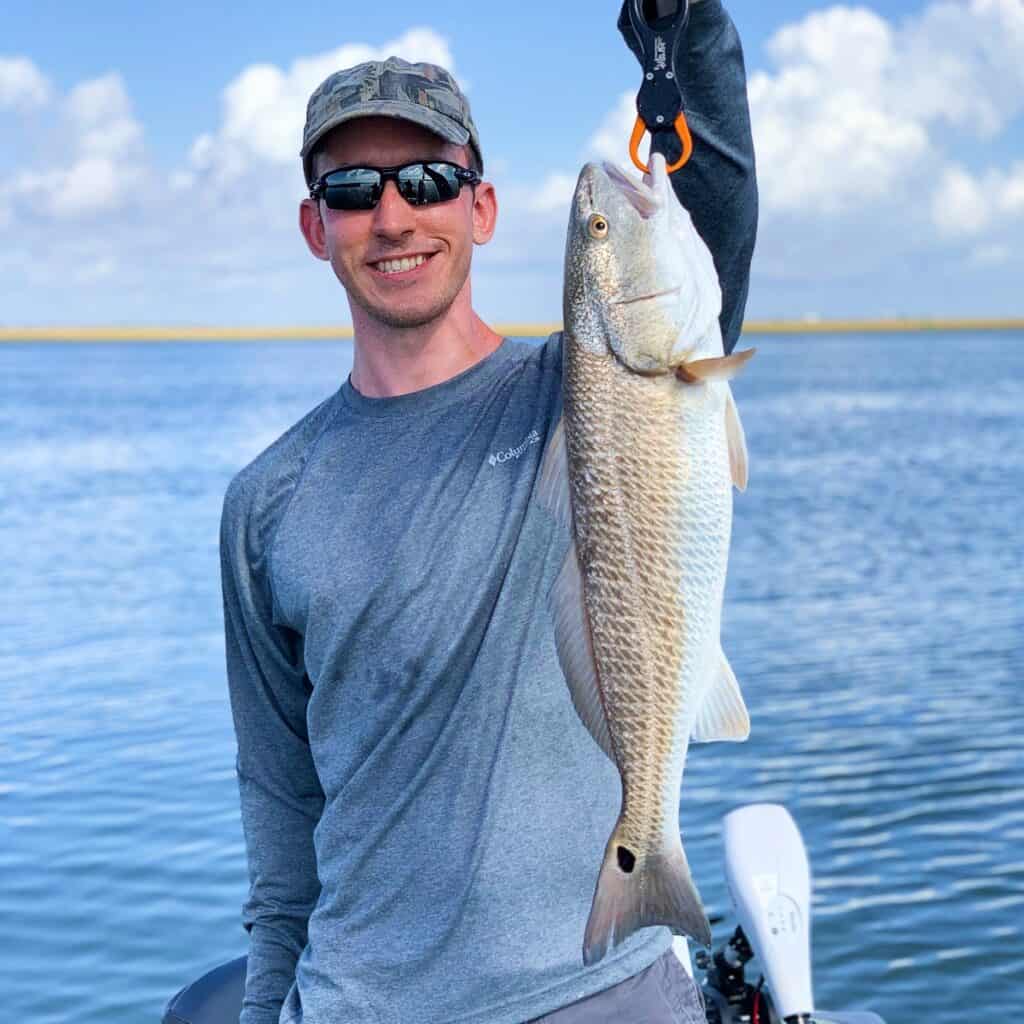
Written By: Andrew Juran
Andrew is a seasoned angler with over 25 years of experience fishing across the United States. He has caught hundreds of saltwater fish using various techniques and mentored many in the art of fishing. An advocate for sustainable fishing, Andrew is an active member of the Coastal Conservation Association, an organization committed to marine conservation.
For frequent fishing tips, behind-the-scenes looks, and real-time catches, connect with Andrew on Instagram









